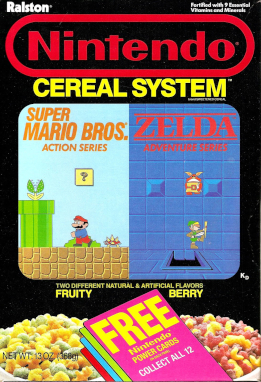This article needs additional citations for verification .(June 2011) |
 | |
| Product type | Cereal |
|---|---|
| Owner | Ralston Cereals, Nintendo Of America |
| Country | U.S. |
| Introduced | 1988 |
| Discontinued | 1989 [1] |
| Markets | U.S. |
Nintendo Cereal System was a breakfast cereal which was produced by Ralston Cereals in 1988 and discontinued in 1989. The name of the cereal was based on the Nintendo Entertainment System, and represents two of the most popular video games for the NES at the time: Super Mario Bros. and The Legend of Zelda . Over the years, the cereal has been sold as memorabilia for collectors on online auction sites, at prices exceeding $100 per box. [2] [3] In 2010, a box was sold on eBay for over $200.